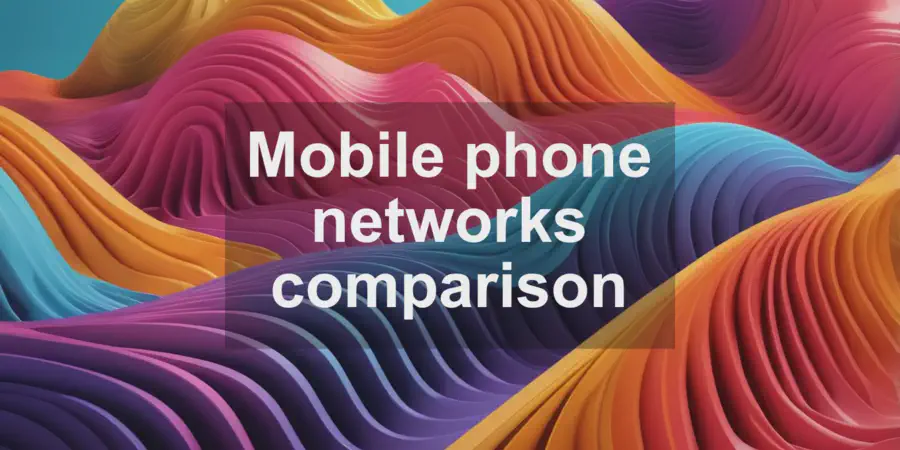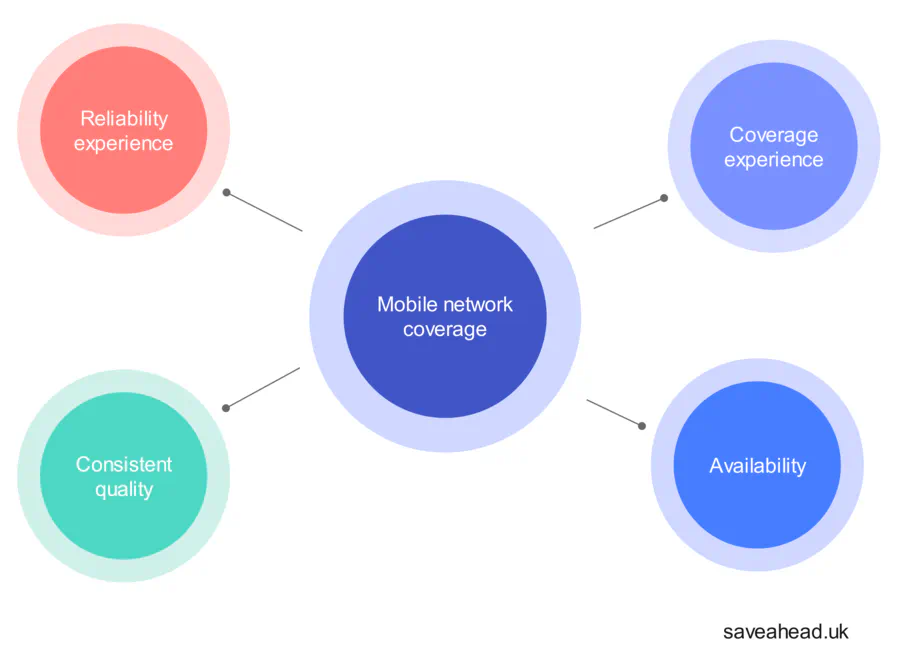Compare the 4 mobile phone networks in the UK: EE, O2, Vodafone, Three
The article compares the UK’s four mobile phone networks: EE, O2, Vodafone, and Three. Comparison focuses on coverage, speed, and reliability.

Staying connected has never been more important, whether for work, socialising, or entertainment. The UK’s mobile phone services offering is large, and choosing the right network can be challenging. With multiple mobile phone networks competing on coverage, speed, and reliability, understanding their strengths and weaknesses is essential.
This article compares the four mobile phone networks maintained by the mobile carriers in the UK (EE, O2, Vodafone, and Three) to help you make an informed decision about which mobile network best suits your needs.
Which are the 4 mobile phone networks in the UK?
The UK’s mobile phone services are primarily delivered by four major operators: EE, O2, Vodafone, and Three. Each of these mobile carriers provides nationwide coverage with varying levels of network quality, speed, and availability. Below, we break down their key strengths.
EE
EE is one of the strongest mobile carriers in the UK, particularly for users who prioritise speed and reliability. EE and Vodafone users enjoy the most reliable mobile experience. Additionally, EE’s customers can connect to 5G in more locations and experience the fastest overall speeds. For those who regularly stream on-demand video or play multiplayer games, EE and Vodafone provide the best user experience.
O2
O2 stands out when it comes to coverage experience. According to industry reports, O2 users enjoy the best network coverage across all generations of mobile technology. This makes O2 a great choice for users who frequently travel across the country and require consistent connectivity.
Vodafone
Vodafone, alongside EE, provides one of the most reliable mobile experiences in the UK. Users on both networks benefit from superior performance when streaming video content or engaging in multiplayer gaming. Vodafone also maintains strong coverage across urban and suburban areas.
Three
Three leads the UK’s 5G speed race, offering the fastest 5G connections. If 5G performance is your priority, Three is a solid choice. However, its overall network coverage and reliability may not match EE and Vodafone in all areas.
Understanding network coverage
Coverage is one of the most critical factors in choosing a mobile network. Several aspects determine network performance, including coverage experience, availability, consistent quality, and reliability experience.

Factors impacting mobile network coverage: coverage experience, availability, consistent quality, reliability experience
Coverage experience
Coverage experience refers to the extent of a network’s presence in areas where users live, work, and travel. Unlike traditional measures that focus solely on geographical reach, this metric considers where users actually expect to have coverage. For example, while remote mountain regions may not be expected to have service, areas like ski resorts should offer reliable connections.
Availability
Availability measures how often users can access a mobile network rather than how widespread the coverage is geographically. This metric focuses on user experience, showing the percentage of time people have a network connection where they commonly use their phones. Indoor connectivity issues, or “dead zones,” are particularly frustrating and are included in availability assessments.
Consistent quality
Consistent quality evaluates whether a network can support everyday mobile activities at an acceptable performance level. This includes factors like download and upload speeds, latency, and stability. A network with high consistent quality ensures users can browse, stream, and communicate without interruptions.
Reliability experience
Reliability experience measures how successfully users can connect to a network and complete basic tasks, such as making voice calls, browsing the web, or streaming standard-definition video. This metric considers disruptions caused by radio access issues or core network failures.
Comparing network coverage across the UK
The performance of mobile phone services varies across different regions in the UK. Here’s how the four major mobile carriers compare in specific locations.
Which network has the best coverage in London?
In London, Three leads in availability, meaning users are connected to a network more frequently. Vodafone excels in consistent quality, ensuring smooth mobile experiences. Meanwhile, EE and Vodafone dominate in reliability experience, making them the top choices for overall connectivity in the capital.

Nelson’s Column at Trafalgar Square in London with London’s double-decker buses
Which network has the best coverage in Scotland?
In Scotland, Three ranks highest in availability, but EE leads in both consistent quality and reliability experience. As a result, EE offers the best overall mobile experience in Scotland.
Which network has the best coverage in Wales?
Wales follows a similar trend to Scotland. Three provides the best availability, but EE outperforms in consistent quality and reliability experience. This makes EE the best choice for mobile connectivity in Wales.
Which network has the best coverage in rural areas?
According to the RootMetrics UK RootScore report, EE is the best network for smaller villages, rural spaces, and roadways. Its extensive network infrastructure makes it the most reliable choice for those who frequently travel outside major cities.
Network access: mobile service provider options
Consumers can access these mobile phone services either directly through the four major mobile carriers (EE, O2, Vodafone, and Three) or through Mobile Virtual Network Operators (MVNOs). MVNOs lease network coverage from the primary providers and often offer competitive pricing and flexible contracts.
Mobile carriers and MVNOs offer SIM-only plans. These plans allow users to keep their existing devices while choosing an airtime plan that suits their data and calling needs. UK MVNOs provide affordable SIM-only deals using EE’s, O2’s, Vodafone’s, or Three’s mobile phone networks.
FAQ
Are O2 and EE the same?
No, O2 and EE are two different mobile phone networks and mobile network operators (MNOs) in the UK.
Which network has the fastest speeds?
EE offers the fastest overall speeds, while Three leads in 5G speed.
Which network is best for rural coverage?
EE provides the best coverage in rural areas, including villages and roadways.
Do MVNOs offer the same coverage as major networks?
Yes, MVNOs use the infrastructure of the main networks, but performance may vary based on traffic prioritisation.
What is the best network for gaming and video streaming?
EE and Vodafone deliver the best experience for streaming and multiplayer gaming.
Final thoughts
Choosing the right mobile phone network depends on what you prioritise most: whether it’s speed, reliability, coverage, or affordability. EE and Vodafone lead in reliability and streaming performance, while O2 provides the widest coverage. Three is the best for 5G speeds but may not offer the same level of consistency across all regions.